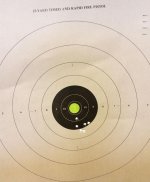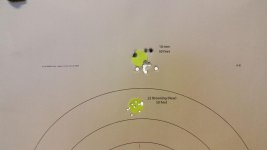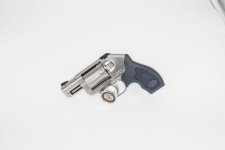I received a NIB K6S yesterday and thought I would post my thoughts on it, should anyone be interested. Note that this review is based on one firearm and with all things, may or may not represent all Kimbers. Nevertheless, here are my findings.
One of the first comments you hear about these is the price. I paid $880 plus $30 shipping. That's less than retail, but perhaps more related is S&W's retail for a 640 is $729 and the PC version retails at $839. There are new K6S models that run considerably more, most noted is the First Edition which retails for $2,039.
First impressions: opening the box. The gun ships in a cardboard box. Inside is a zippered pouch bearing the Kimber name with the K6S nestled inside. Also in the box is the usual paperwork, including instruction manual, NRA application and Kimber decal. Besides the gun, the pouch also contains a plastic speed clip. More on that later. Removing the gun from the pouch revealed a very nice looking firearm. Fits and finish were top notch. The stainless is a matte finish, somewhere short of shiny, but far from bead blasted. The over all finish is very smooth and there are no tooling or brush marks. One surprise (for me) were the grips are made by Crimson Trace, though they contain no laser. Crimson Trace does make a set of laser grips for the K6S, at a retail price of $399.99. Finding a set may be a problem though as even CT lists them as out of stock.
As noted, the gun is to notch for fit and overall finish. The sights are plain and black, which provides a rather pleasing contrast to the stainless. However like all black sights, they tend to disappear in low light, especially against a dark target. Kimber seems to have known this though as both front and rear sight are easily replaceable, something that can't be said on S&W J frames. The cylinder latch is unique in being a "push button". It is easy to use, yet very positive in its action. The cylinder and crane/yoke swing out easily, revealing nicely machined counter sunk chambers. The assembly closes a little stiff, given the strong spring action of cylinder pin. This isn't a problem, but it felt a bit strange given the ease in which the assembly opened. Closed, you will note the cylinder fits very snugly in the frame.
Comparing the K6S with my older 640, I found the Kimber to be a bit longer over all, somewhere between 1/8 and 1/4 inch, and over all beefier. However my 640 is the .38 Special version. Comparing the K6S to a .357 J-frame would most likely show the two to be very similar both in size and weight. As for feel in my hand, the K6S felt very good, much like the 640. The trigger on the K6S has received rave reviews. I'd like to meet those reviewers. The trigger on my K6S was smooth, but has a rather long take up between the cylinder locking up and the internal hammer falling. It wasn't bad, just a bit weird to me. However compared to my 640, the K6S' trigger didn't justify its price as some of the reviews seem to hint at. In full disclosure, my 640 has had the trigger return spring replaced and a honing job by moi. One point I'd like to make here is given the two retail prices, sending a J frame out for a trigger job would put it up in the price range of the K6S, however you would in the end have a better trigger with the J Frame. I would also note that the new J frames contain MIM parts, which despite their naysayers, are much smoother than their machined counter parts, so a simple return spring change may be all that's needed to get a smoother trigger. My bottom line here is that while the trigger pull on the K6S isn't bad, it's not as good as I was led to believe it would be, given the reviews. Could the trigger on my particular gun be made better? Perhaps, but I've not pulled the side plate off to see how the internals look, let alone have the knowledge on what would need to be worked on. Besides, the trigger is supposed to be one of the major selling points to justify the price of this gun. The last thing I'll say on this is there is, as of now, no replacement springs or parts or even guidelines on working on this gun to improve the trigger. So at best, all I could do is maybe smooth out some parts and add lubrication.
One distinct advantage the gun has over the J frame is it's a 6 shooter instead of a 5. The cylinder is also different in that it is machined flat between chambers rather than left smooth or scalloped like Smiths. It's a different look, but not unpleasing, in my opinion. I mentioned earlier that the gun came with a speed strip. In looking at the open cylinder, I wonder if a K frame speed loader would work. The Kimber does not have a lot of room with the cylinder open though, and I'm not sure most speed loaders have enough room. That's an area I'll have to research on. To my knowledge, there are no speed loaders other than the strip available yet. My fear is the cylinder release, which I really like, sticks out too far and will impede any speed loader currently on the market.
At this time, I cannot give a range report, as I don't expect to make it to the range with the K6S until next week. I don't suspect there will be any accuracy issues with the gun, but I'm more interested to see how it preforms with full house .357 ammo. When I do go, I'll come back here and up date this report.
So, without actually firing the gun, what are my feelings? If all things were equal, I'd buy one of S&W's J frames. The J's come in a world of different flavors, weights and even calibers. However there are two areas the K6S stand out: the ability to change the sights (once replacements become available, which will surely happen when the aftermarket ramps up) and the overall attention to finish. Do these two differences justify the price difference, especially when used J frames are several hundred dollars cheaper than a new K6S? That's a question the buyer will have to answer. If you are seriously considering buying one of these revolvers, I recommend you do more research. There are a host of reviews out there to read. Just don't believe everything they say about the trigger.
One of the first comments you hear about these is the price. I paid $880 plus $30 shipping. That's less than retail, but perhaps more related is S&W's retail for a 640 is $729 and the PC version retails at $839. There are new K6S models that run considerably more, most noted is the First Edition which retails for $2,039.
First impressions: opening the box. The gun ships in a cardboard box. Inside is a zippered pouch bearing the Kimber name with the K6S nestled inside. Also in the box is the usual paperwork, including instruction manual, NRA application and Kimber decal. Besides the gun, the pouch also contains a plastic speed clip. More on that later. Removing the gun from the pouch revealed a very nice looking firearm. Fits and finish were top notch. The stainless is a matte finish, somewhere short of shiny, but far from bead blasted. The over all finish is very smooth and there are no tooling or brush marks. One surprise (for me) were the grips are made by Crimson Trace, though they contain no laser. Crimson Trace does make a set of laser grips for the K6S, at a retail price of $399.99. Finding a set may be a problem though as even CT lists them as out of stock.
As noted, the gun is to notch for fit and overall finish. The sights are plain and black, which provides a rather pleasing contrast to the stainless. However like all black sights, they tend to disappear in low light, especially against a dark target. Kimber seems to have known this though as both front and rear sight are easily replaceable, something that can't be said on S&W J frames. The cylinder latch is unique in being a "push button". It is easy to use, yet very positive in its action. The cylinder and crane/yoke swing out easily, revealing nicely machined counter sunk chambers. The assembly closes a little stiff, given the strong spring action of cylinder pin. This isn't a problem, but it felt a bit strange given the ease in which the assembly opened. Closed, you will note the cylinder fits very snugly in the frame.
Comparing the K6S with my older 640, I found the Kimber to be a bit longer over all, somewhere between 1/8 and 1/4 inch, and over all beefier. However my 640 is the .38 Special version. Comparing the K6S to a .357 J-frame would most likely show the two to be very similar both in size and weight. As for feel in my hand, the K6S felt very good, much like the 640. The trigger on the K6S has received rave reviews. I'd like to meet those reviewers. The trigger on my K6S was smooth, but has a rather long take up between the cylinder locking up and the internal hammer falling. It wasn't bad, just a bit weird to me. However compared to my 640, the K6S' trigger didn't justify its price as some of the reviews seem to hint at. In full disclosure, my 640 has had the trigger return spring replaced and a honing job by moi. One point I'd like to make here is given the two retail prices, sending a J frame out for a trigger job would put it up in the price range of the K6S, however you would in the end have a better trigger with the J Frame. I would also note that the new J frames contain MIM parts, which despite their naysayers, are much smoother than their machined counter parts, so a simple return spring change may be all that's needed to get a smoother trigger. My bottom line here is that while the trigger pull on the K6S isn't bad, it's not as good as I was led to believe it would be, given the reviews. Could the trigger on my particular gun be made better? Perhaps, but I've not pulled the side plate off to see how the internals look, let alone have the knowledge on what would need to be worked on. Besides, the trigger is supposed to be one of the major selling points to justify the price of this gun. The last thing I'll say on this is there is, as of now, no replacement springs or parts or even guidelines on working on this gun to improve the trigger. So at best, all I could do is maybe smooth out some parts and add lubrication.
One distinct advantage the gun has over the J frame is it's a 6 shooter instead of a 5. The cylinder is also different in that it is machined flat between chambers rather than left smooth or scalloped like Smiths. It's a different look, but not unpleasing, in my opinion. I mentioned earlier that the gun came with a speed strip. In looking at the open cylinder, I wonder if a K frame speed loader would work. The Kimber does not have a lot of room with the cylinder open though, and I'm not sure most speed loaders have enough room. That's an area I'll have to research on. To my knowledge, there are no speed loaders other than the strip available yet. My fear is the cylinder release, which I really like, sticks out too far and will impede any speed loader currently on the market.
At this time, I cannot give a range report, as I don't expect to make it to the range with the K6S until next week. I don't suspect there will be any accuracy issues with the gun, but I'm more interested to see how it preforms with full house .357 ammo. When I do go, I'll come back here and up date this report.
So, without actually firing the gun, what are my feelings? If all things were equal, I'd buy one of S&W's J frames. The J's come in a world of different flavors, weights and even calibers. However there are two areas the K6S stand out: the ability to change the sights (once replacements become available, which will surely happen when the aftermarket ramps up) and the overall attention to finish. Do these two differences justify the price difference, especially when used J frames are several hundred dollars cheaper than a new K6S? That's a question the buyer will have to answer. If you are seriously considering buying one of these revolvers, I recommend you do more research. There are a host of reviews out there to read. Just don't believe everything they say about the trigger.



